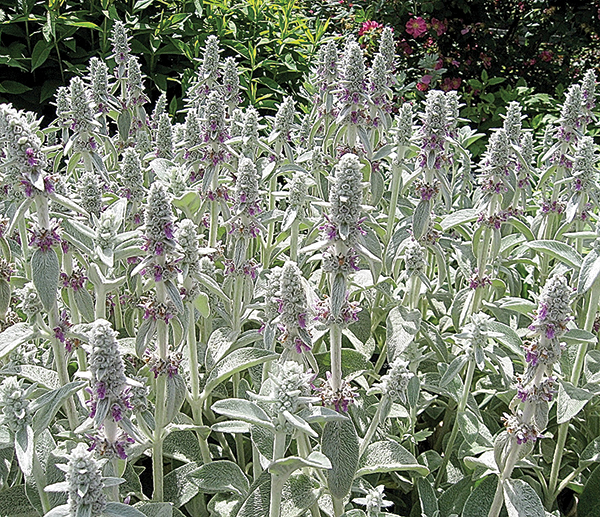
Meldony Phillips
Staff Writer
Considering the fact that I love being outside, and I am a super penny pincher, I often handle minor wounds differently than many people I know; sometimes, even worse injuries, as well. Why spend money on bandages when when they’re not needed? Just grow them.
When my boys were young and inevitably received scrapes, cuts, etc., as children do, they rarely ran to me during the summer to ask for a bandage. If it was in season, they used the opportunity to pick some Lamb’s Ear from the garden. They thought the velvety soft leaves were fun to touch and play with and super cool when used an instant bandage.
About
Lamb’s Ear, Stachys byzantine, is a perennial herb native to Turkey, Armenia and Iran, but is cultivated throughout the world. Some of its other names include: Lamb’s Wool, Silver Carpet, Donkey’s Ear, Jesus Flannel, Woolly Betony, Wood Betony, Big Ears, Lamb’s Tongue and Woolly Hedgenettle.
Lamb’s Ear is of the mint family. It grows to 12 to 18 inches tall in hardy zones 4-8. It usually produces tall purple flower heads that bloom from May through July, and it flaunts grayish-green oblong leaves which are covered in velvety silvery fuzz. When crushed, the leaves may have an apple-like or fruity smell. Lamb’s Ear effortlessly spreads by roots, or by crawling, creating a dense mat along the ground; it also spreads by seed distribution. Preferring full sun and dry to medium soil, Lamb’s Ear grows well in poor soil conditions.
Lamb’s Ear pairs nicely with rose gardens and works well for borders and rock gardens as it is a ground cover that attracts bees, butterflies and hummingbirds. It may become invasive in some areas.
Cultivating
Start seeds indoors 8-to-10 weeks before the last frost date but be patient as it may take a month to germinate. Procreating from a cutting or split from a parent plant is an easy way to start some in a new location. Lamb’s Ear is drought tolerant, preferring drier soil, and tolerant to many animals such as deer and rabbits. Planting in moist soil may cause the development of diseases or root rot so good drainage is important for healthy plants. Cut Lamb’s Ear back in the fall to prevent the leaves from rotting.
Historical uses
The use of Lamb’s Ear for bandages dates back to the medieval times, and is commonly referred to during the American Civil War. The soft fuzzy leaves sop up blood and causes clotting which slows bleeding. Sometimes used as a dressing by itself, Lamb’s Ear was also used to hold other herbs and poultices on a wound.
In the West Indies, the leaves have been used in cooking and as a tea, which tastes similar to chamomile.
This plant is widely consumed as aromatic teas in Europe and Asia.
Medical reports
One study stated, “Various Stachys species (especially St. byzantina and St. persica) are valuable sources of natural compounds with important biological properties.”
In another study, on the decoction of Stachys species, done by ScienceDirect, said, “Therapeutic enzymes inhibition experiments showed moderate anti-cholinester-ase… and strong anti-tyrosinase… properties for Sta- chys herbal teas.”
“Cholinesterase inhibitors…” according to the National Library of Medicine, NBK544336, “… are a group of drugs that block the normal breakdown of acetylcholine … Most commonly, their use is in treating neurogenerative diseases such as Alzheimer disease, Parkinson disease and Lewy body dementia … as well as frequent use in patients with myasthenia gravis…’
Constituents and actions
Lamb’s Ear is antiseptic, antimicrobial, astringent, anticancer, antispasmodic, sed-ative and diuretic. It contains the alkaloids, stachydrene, trigonelline and betonicine, which are antibacterial, antimitotic, anti-inflammatory, analgesic (pain relief), local anesthetic, hypnotic, psychotropic, has antitumor activity and many others.
Uses
Externally, Lamb’s Ear is used as a bandage, for bruises, wounds, neuralgia and other nerve pains, muscle cramps, skin or mouth wash, canker sores, to line footwear – and for toilet paper.
Internally this plant is used for hypertension, dropsy, asthma, dysentery, diarrhea, Dyspepsia, bladder stones, kidney stone, headache, gout, nephrosis, neuralgia and other nerve pains, muscle cramps and sore throat.
It is best to harvest Lamb’s Ear in the summer as it begins to flower. To make an infusion, pour one cup of boiling water over 1 tsp. dried aerial parts and allow it to steep for 10-to-15 minutes. You can drink this three times per day. Alternatively, a tincture of 1-2 ml, three times per day can be used. For more severe issues and headaches, a doubled strength dose (2 tsp. dried or 2-4 ml tincture) can be used.
Take home
• Lamb’s ear is edible with a fruity taste similar to a combination of apples and pineapples. Can be used in salads or made into infusions/ teas.
• Velvety soft renewable and compostable resource for bandages
• Has a long list of uses both externally and internally
• Easily grown multipurpose plant
• A low maintenance pleasant ground cover with purplish-pink blooms
• Fun to handle and good for kids’ gardens
• Toilet paper that can be harvested in your back yard – septic tanks may not like it, though.



Thank you for the information. It’d was very helpful.
New subject.
How do you make your tincture ?
And would you take it 3 times a day as opposed to cups of tea or tablets ?
Barbara Zamora -Athy